人力资源管理 HRM human resource managemnt
人力资源管理(HRM)HumanResourceMan
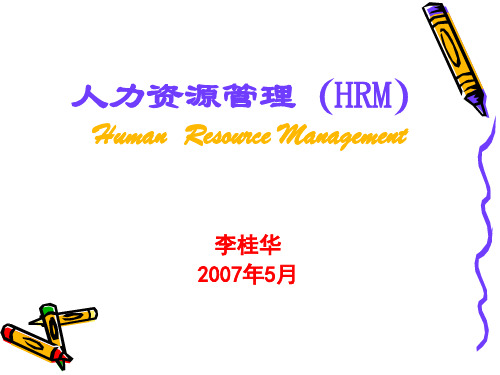
(3)人力资源规划是不是反对变化,而是预测变化、 应对变化。
(4)人力资源规划的主要工作是制定必要的人力资源 政策和措施。
人力资源规划的价值
• 解决人力资源需求与缺口的问题; • 在人力资源方面确保实施组织目标; • 对组织紧缺的人力资源发出引进与培训
组织内外部的环境
组织拥有 的资源
计划 控制
组织 领导
组织既定 的目标
管理活动示意图
有效的 方式
人力资源管理的含义
• 所谓人力资源管理就是指企业为了选、育、 用、留生产经营过程中必不可少的人力资 源,通过运用科学、系统的技术和方法进 行各种相关的计划、组织、领导和控制活 动,以实现企业的既定目标。
人力资源管理的属性
•
安全在于心细,事故出在麻痹。20.11 .2120. 11.211 9:30:2 019:30 :20November 21, 2020
•
加强自身建设,增强个人的休养。20 20年11 月21 日下午7 时30分 20.11. 2120.1 1.21
•
扩展市场,开发未来,实现现在。20 20年11 月21 日星期 六下午7 时30分 20秒1 9:30:2 020.11 .21
•
பைடு நூலகம்
安全在于心细,事故出在麻痹。20.11 .2120. 11.211 9:30:2 019:30 :20November 21, 2020
•
加强自身建设,增强个人的休养。20 20年11 月21 日下午7 时30分 20.11. 2120.1 1.21
•
扩展市场,开发未来,实现现在。20 20年11 月21 日星期 六下午7 时30分 20秒1 9:30:2 020.11 .21
人力资源各专业的缩写
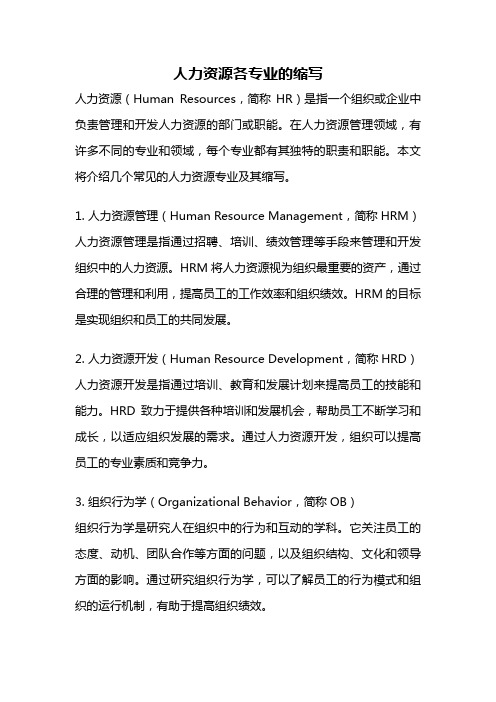
人力资源各专业的缩写人力资源(Human Resources,简称HR)是指一个组织或企业中负责管理和开发人力资源的部门或职能。
在人力资源管理领域,有许多不同的专业和领域,每个专业都有其独特的职责和职能。
本文将介绍几个常见的人力资源专业及其缩写。
1. 人力资源管理(Human Resource Management,简称HRM)人力资源管理是指通过招聘、培训、绩效管理等手段来管理和开发组织中的人力资源。
HRM将人力资源视为组织最重要的资产,通过合理的管理和利用,提高员工的工作效率和组织绩效。
HRM的目标是实现组织和员工的共同发展。
2. 人力资源开发(Human Resource Development,简称HRD)人力资源开发是指通过培训、教育和发展计划来提高员工的技能和能力。
HRD致力于提供各种培训和发展机会,帮助员工不断学习和成长,以适应组织发展的需求。
通过人力资源开发,组织可以提高员工的专业素质和竞争力。
3. 组织行为学(Organizational Behavior,简称OB)组织行为学是研究人在组织中的行为和互动的学科。
它关注员工的态度、动机、团队合作等方面的问题,以及组织结构、文化和领导方面的影响。
通过研究组织行为学,可以了解员工的行为模式和组织的运行机制,有助于提高组织绩效。
4. 劳动关系(Labor Relations,简称LR)劳动关系是指雇主和员工之间的关系和互动。
劳动关系包括劳动合同、薪酬福利、劳动法律等方面的问题。
通过建立良好的劳动关系,可以促进员工的满意度和忠诚度,减少劳资纠纷,提高工作效率。
5. 工资福利管理(Compensation and Benefits Management,简称CBM)工资福利管理是指制定和管理员工工资和福利政策的过程。
它包括确定工资水平、福利计划、绩效奖金等方面的工作。
通过合理的工资福利管理,可以激励员工的工作积极性,提高员工的工作满意度。
人力资源管理概念 Human Resource Management

一、人力资源管理概念Human Resource Management1、人口、人力资源、人才的关系(1)人口(2)人力资源(3)人才:1>杰出的人2>专门人才的缩略语3>才能4>相貌它们三者的范围在逐渐地缩小,之间是一种包含与被包含的关系。
三者并不是等同的,三者具有不同的范围。
2、人力资源是一种特殊的资源人力资源它把人看做一种资源,同种物质资源、信息资源相对应,他们共同构成了企业的三大资源,它的特殊性表现在:(1)、人力资源是一种“活”的资源(2)、人力资源是创造利润的主要来源(3)、人力资源是一种战略性资源(4)、人力资源具有主观能动性、可以持续发展(5)、人力资源具有时效性(6)、人力资源具有社会性a+b+c+d=现实人力资源e+f+g+h=潜在人力资源现实人力资源+潜在人力资源=HR4、人力资本:人力资本的货币表征特点:○1人力资本具有资本最一般的特性,可以带来利润。
○2人力资本可以用数量、质量来衡量○3人力资本主要存在于人的身上,表现为人的脑力、体力、潜力○4对人力资本的投资是回报最高的投资,因为人的创造力是非常惊人的。
5、教材上的定义P1_P2教材上将人力资源的定义划分为宏观和微观两个层面宏观:人口学、社会学层面之上的,了解即可微观:从组织的角度。
掌握并记忆二、人力资源管理的概念1、概念○1人力资源管理是有效地管理工作中的人,专门负责与人与员工有关的问题,利用企业现有的人力资源,通过人与人关系的处理,人与事关系的配合,发挥员工的作用和潜能,实现组织的目标。
○2与组织中的人(或人力资源)相关的所有管理决策和实践,其目的是为了实现企业的目标。
2、人力资源管理的基本目的:○1吸引a>怎样吸引?b>吸引什么样的人?不一定是最优秀的,优秀的固然好,但最合适的才是最好的。
○2保留○3激励a>员工积极性的高低与企业目标的实现积极性企业目标调动员工积极性是要使其积极性的努力方向与企业目标一致。
人力资源管理的基本框架
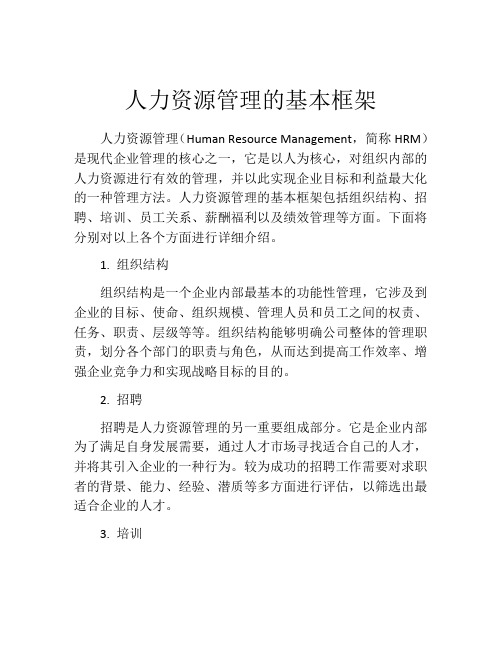
人力资源管理的基本框架人力资源管理(Human Resource Management,简称HRM)是现代企业管理的核心之一,它是以人为核心,对组织内部的人力资源进行有效的管理,并以此实现企业目标和利益最大化的一种管理方法。
人力资源管理的基本框架包括组织结构、招聘、培训、员工关系、薪酬福利以及绩效管理等方面。
下面将分别对以上各个方面进行详细介绍。
1. 组织结构组织结构是一个企业内部最基本的功能性管理,它涉及到企业的目标、使命、组织规模、管理人员和员工之间的权责、任务、职责、层级等等。
组织结构能够明确公司整体的管理职责,划分各个部门的职责与角色,从而达到提高工作效率、增强企业竞争力和实现战略目标的目的。
2. 招聘招聘是人力资源管理的另一重要组成部分。
它是企业内部为了满足自身发展需要,通过人才市场寻找适合自己的人才,并将其引入企业的一种行为。
较为成功的招聘工作需要对求职者的背景、能力、经验、潜质等多方面进行评估,以筛选出最适合企业的人才。
3. 培训培训是员工成长和提高的重要途径,也是企业提高竞争力的必要措施。
企业需要根据其发展需要,为员工量身定制的培训计划,包括企业文化、市场营销、管理技能等方面的培训,从而提升员工的能力,为企业发展提供有力保障。
4. 员工关系员工关系是企业内部最基本的人际沟通问题。
企业需要积极建立并改善员工关系,建立良好的员工沟通渠道和员工福利保障制度,加强员工对企业的认同感,降低员工流动率和劳资纠纷率,保持企业员工的稳定性,为企业创造持续的发展环境。
5. 薪酬福利薪酬福利是员工对企业回报的直接体现,也是员工对企业的认可度和满意度的重要衡量指标。
企业应根据员工的能力和业绩分配薪酬,包括年终奖、股票期权、福利待遇、补贴等方面,建立完善的薪酬福利体系,激发员工的潜能,提高工作积极性和满意度。
6. 绩效管理绩效管理是企业内部对员工工作表现进行评估的方法。
它不仅可以帮助企业掌握员工的工作表现,还可以为企业制定人才激励和使用计划,提高员工的职业成长和企业的竞争力。
英文hrmhrd代表的是什么意思

英文hrmhrd代表的是什么意思英文hrm hrd代表的是什么意思英文hrm和hrd都是人事领域的专业术语,那么它们代表的中文意思是什么呢?为此店铺为大家带来英文hrm hrd代表的中文意思。
hrd的网路解释1、人力资源开发:(tions) 为计算机用户培训多媒体制作技巧芯片设计VLSI(DiplomainVeryLargeScaleIntegrationDesign) 培养电子设计自动化的设计人附录人力资源开发(HRD) 在印度政府发表的IT 行动计划第三部分:长期国家IT政策(1999年4月),2、人力资源开发部:根据知识产权法,该委员会连同人力资源开发部(HRD)一并指控,指出Sansthan剽窃了该委员出版的辅助教材内容,并用于其自身的出版物,即Vartika(梵文版)和Manjari(印地语版),第七、八、九册辅助教材。
3、听到:HR:这里、小时| HRD:听到 | HUM:交流声4、克罗地亚第纳尔:HNL 伦皮拉 | HRD 克罗地亚第纳尔 | HRK 克罗地亚 kuna5、hrd:the human resources development; 人力资源开发6、hrd:high-rate discharge ability; 高倍率7、hrd:hardware reference design; 硬件参考设计〖网络计算机〗8、hrd:hemorrhagic retinal detachment; 出血性视网膜脱离hrd的解释HRM,是Human Resource Manager的英文缩写,可翻译为人事经理。
HRM=Human Resource Manager.人力资源经理。
是近几年在企业中出现的新兴热门职位。
也就是cho(人力执行官)的初级阶段。
HRM 是human resource management的缩写,是指人力资源管理(也叫HR管理)。
英文hrm和hrd的区别HRM几乎每个公司都有,不管规模大小,业务复杂或单一。
人力资源管理学中经常出现的英文缩写都有哪些?它们的含义?

人力资源管理学中经常出现的英文缩写都有哪些?它们的含义?一、人力资源管理:(Human Resource Management ,HRM) 人力资源经理:( human resource manager) 高级管理人员:(executive) / i`gzekjutiv 职业:(profession) 道德标准:(ethics) 操作工:(operative employees) 专家:(speci alist) 人力资源认证协会:(the Human Resource Certification Institute,HRCI) 二、外部环境:(external environme nt) 内部环境:(internal environment) 政策:(policy) 企业文化:(corporate culture) 目标:(mission) 股东:(sharehold ers) 非正式组织:(informal organization) 跨国公司:(multinational corporation,MNC) 管理多样性:(managing dive rsity) 三、工作:(job) 职位:(posting) 工作分析:(job analysis) 工作说明:(job description) 工作规范:(job specificat ion) 工作分析计划表:(job analysis schedule,JAS) 职位分析问卷调查法:(Management Position Description Qu estionnaire,MPDQ) 行政秘书:(executive secretary) 地区服务经理助理:(assistant district service manager) 四、人力资源计划:(Human Resource Planning,HRP) 战略规划:(strategic planning) 长期趋势:(long term trend) 要求预测:(requirement forecast) 供给预测:(availability forecast) 管理人力储备:(management inventory) 裁减:(do wnsizing) 人力资源信息系统:(Human Resource Information System,HRIS) 五、招聘:(recruitment) 员工申请表: (employee requisition) 招聘方法:(recruitment methods) 内部提升:(Promotion From Within ,PFW) 工作公告:(j ob posting) 广告:(advertising) 职业介绍所:(employment agency) 特殊事件:(special events) 实习:(internship) 六、选择:(selection) 选择率:(selection rate) 简历:(resume) 标准化:(standardization) 有效性:(validity) 客观性:(o bjectivity) 规范:(norm) 录用分数线:(cutoff score) 准确度:(aiming) 业务知识测试:(job knowledge tests) 求职面试:(employment interview) 非结构化面试:(unstructured interview) 结构化面试:(structured interview) 小组面试: (group interview) 职业兴趣测试:(vocational interest tests) 会议型面试:(board interview) 七、组织变化与人力资源开发人力资源开发:(Human Resource Development,HRD) 培训:(training) 开发:(development) 定位:(orientat ion) 训练:(coaching) 辅导:(mentoring) 经营管理策略:(business games) 案例研究:(case study) 会议方法:(conf erence method) 角色扮演:(role playing) 工作轮换:(job rotating) 在职培训:(on-the-job training ,OJT) 媒介:(me dia) 八、企业文化与组织发展企业文化:(corporate culture) 组织发展:(organization development,OD) 调查反馈: (survey feedback) 质量圈:(quality circles) 目标管理:(management by objective,MBO) 全面质量管理:(Total Q uality Management,TQM) 团队建设:(team building) 九、职业计划与发展职业:(career) 职业计划:(career plann ing) 职业道路:(career path) 职业发展:(career development) 自我评价:(self-assessment) 职业动机:(career anc hors) 十、绩效评价绩效评价:(Performance Appraisal,PA) 小组评价:(group appraisal) 业绩评定表:(rating scal es method) 关键事件法:(critical incident method) 排列法:(ranking method) 平行比较法:(paired comparison)硬性分布法:(forced distribution method) 晕圈错误:(halo error) 宽松:(leniency) 严格:(strictness) 3600反馈:(360 -degree feedback) 叙述法:(essay method) 集中趋势:(central tendency) 十一、报酬与福利报酬:(compensatio n) 直接经济报酬:(direct financial compensation) 间接经济报酬:(indirect financial compensation) 非经济报酬: (no financial compensation) 公平:(equity) 外部公平:(external equity) 内部公平:(internal equity) 员工公平:(em ployee equity) 小组公平:(team equity) 工资水平领先者:(pay leaders) 现行工资率:(going rate) 工资水平居后者: (pay followers) 劳动力市场:(labor market) 工作评价:(job evaluation) 排列法:(ranking method) 分类法:(classifi cation method) 因素比较法:(factor comparison method) 评分法:(point method) 海氏指示图表个人能力分析法: (Hay Guide Chart-profile Method) 工作定价:(job pricing) 工资等级:(pay grade) 工资曲线:(wage curve) 工资幅度:(pay range) 十二、福利和其它报酬问题福利(间接经济补偿) 员工股权计划:(employee stock ownership pl an,ESOP) 值班津贴:(shift differential) 奖金:(incentive compensation) 分红制:(profit sharing) 十三、安全与健康的工作环境安全:(safety) 健康:(health) 频率:(frequency rate) 紧张:(stress) 角色冲突:(role conflict) 催眠法:(hy pnosis) 酗酒:(alcoholism) 十四、员工和劳动关系工会:(union) 地方工会:(local union) 行业工会:(craft union)产业工会:(industrial union) 全国工会:(national union) 谈判组:(bargaining union) 劳资谈判:(collective bargaining) 仲裁:(arbitration) 罢工:(strike) 内部员工关系:(internal employee relations) 纪律:(discipline) 纪律处分:(discip linary action) 申诉:(grievance) 降职:(demotion) 调动:(transfer) 晋升:(promotion)。
人力资源管理英文怎么说呢

人力资源管理英文怎么说呢人力资源管理是现代企业中非常重要的一项工作,它涉及到招聘、培训、薪酬、绩效管理等多个方面。
下面我们来看看人力资源管理的英文怎么说吧!一、人力资源管理的定义Human Resource Management(简称HRM),也可翻译为Personnel Management,是一门较为综合的管理学科,主要研究和应用如何有效地组织、利用和开发企业的人力资源。
它旨在通过科学、系统地管理和规划人力资源,提高员工的绩效和组织的效益。
二、人力资源管理的核心职能人力资源管理的核心职能包括:1. 招聘与选拔(Recruitment and Selection)这一职能包括人才需求分析、招聘渠道策划、简历筛选、面试评估等环节,旨在吸引并选拔具备相关能力和特质的候选人。
2. 培训与发展(Training and Development)培训与发展职能涉及到员工的职业生涯规划、培训需求评估、培训计划设计和培训评估等方面,旨在提升员工的工作技能和个人发展。
3. 绩效管理(Performance Management)绩效管理包括绩效目标设定、绩效评估、反馈和奖惩等环节,旨在衡量和提升员工的工作绩效,以促进组织的整体绩效。
4. 薪酬与福利(Compensation and Benefits)薪酬与福利管理涉及到岗位薪资设计、绩效奖励、员工福利制度等,旨在提供合理的薪酬激励,保障员工的工作满意度和福利享受。
5. 劳动关系与员工沟通(Labor Relations and Employee Communication)劳动关系管理包括与工会的沟通协商、劳动争议处理、员工关系维护等方面,旨在建立和维护良好的劳动关系和员工沟通渠道。
三、人力资源管理的重要性人力资源管理对企业的发展和竞争力具有极大的影响。
它能够帮助企业优化组织结构,提高员工的工作效益,创造良好的工作氛围,加强员工的凝聚力和归属感。
同时,人力资源管理还能促进组织中人才的合理配置,提高招聘选拔的精确度和效率,加强培训开发的科学性和针对性,提高绩效评估的公正性和准确性,维护劳动关系的和谐稳定。
管理学中人力资源管理的名词解释
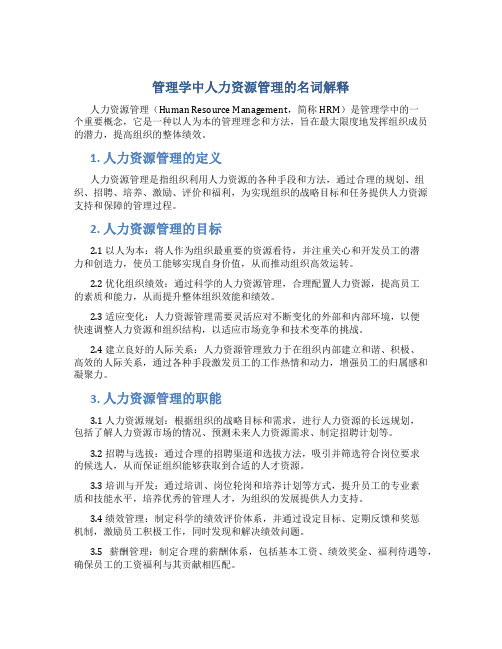
管理学中人力资源管理的名词解释人力资源管理(Human Resource Management,简称HRM)是管理学中的一个重要概念,它是一种以人为本的管理理念和方法,旨在最大限度地发挥组织成员的潜力,提高组织的整体绩效。
1. 人力资源管理的定义人力资源管理是指组织利用人力资源的各种手段和方法,通过合理的规划、组织、招聘、培养、激励、评价和福利,为实现组织的战略目标和任务提供人力资源支持和保障的管理过程。
2. 人力资源管理的目标2.1 以人为本:将人作为组织最重要的资源看待,并注重关心和开发员工的潜力和创造力,使员工能够实现自身价值,从而推动组织高效运转。
2.2 优化组织绩效:通过科学的人力资源管理,合理配置人力资源,提高员工的素质和能力,从而提升整体组织效能和绩效。
2.3 适应变化:人力资源管理需要灵活应对不断变化的外部和内部环境,以便快速调整人力资源和组织结构,以适应市场竞争和技术变革的挑战。
2.4 建立良好的人际关系:人力资源管理致力于在组织内部建立和谐、积极、高效的人际关系,通过各种手段激发员工的工作热情和动力,增强员工的归属感和凝聚力。
3. 人力资源管理的职能3.1 人力资源规划:根据组织的战略目标和需求,进行人力资源的长远规划,包括了解人力资源市场的情况、预测未来人力资源需求、制定招聘计划等。
3.2 招聘与选拔:通过合理的招聘渠道和选拔方法,吸引并筛选符合岗位要求的候选人,从而保证组织能够获取到合适的人才资源。
3.3 培训与开发:通过培训、岗位轮岗和培养计划等方式,提升员工的专业素质和技能水平,培养优秀的管理人才,为组织的发展提供人力支持。
3.4 绩效管理:制定科学的绩效评价体系,并通过设定目标、定期反馈和奖惩机制,激励员工积极工作,同时发现和解决绩效问题。
3.5 薪酬管理:制定合理的薪酬体系,包括基本工资、绩效奖金、福利待遇等,确保员工的工资福利与其贡献相匹配。
3.6 员工关系管理:建立和谐良好的员工关系,包括沟通、冲突解决、员工参与和福利待遇等方面,增强组织凝聚力和员工满意度。
人力资源名词解释

人力资源名词解释人力资源是指组织或企业中与人力相关的各种活动和要素。
在人力资源管理中,有许多重要的名词需要正确理解和解释。
下面,我们将对其中几个常见的人力资源名词进行解释和探讨。
1. 人力资源管理(HRM)人力资源管理是指负责管理和组织企业员工工作的一组活动。
它涉及招聘、培训、薪酬福利、绩效考核等方面,旨在保证组织能够吸引、培养、激励和保留优秀人才,从而实现组织目标和长期发展。
2. 招聘与选拔招聘与选拔是人力资源管理的重要环节,旨在从各种渠道中吸引并筛选合适的人才。
招聘是指发布职位需求信息、吸引求职者投递简历的过程,而选拔则是对各个求职者进行筛选和面试,最终选择适应岗位要求的人才。
3. 培训与开发培训与开发是指为员工提供适应岗位的技能和知识,以提高他们的绩效和个人发展。
培训可以通过内部培训、外部培训、课程培训等形式进行。
开发则是通过给予员工更高级别的工作任务和挑战,促使其不断成长和发展。
4. 绩效管理绩效管理是指评估和衡量员工在工作中所取得的成绩和表现的一种管理方式。
通过设定明确的绩效目标,并进行定期的评估和反馈,可以激励员工提高工作绩效,也有助于组织根据绩效情况做出相应的奖惩和激励措施。
5. 薪酬福利薪酬福利是指员工在工作中所获得的各种物质和非物质的报酬。
物质方面包括工资、奖金、津贴等,非物质方面则包括健康保险、带薪假期、培训补贴等。
合理的薪酬福利政策可以吸引和激励员工,提高员工对组织的忠诚度和工作积极性。
6. 组织文化组织文化是指一种共同的、隐性的价值观和行为模式,存在于组织中的各个层面。
它能够在员工中形成共同的认同感和归属感,促使员工更好地适应组织的目标和价值观,并以此为基础推动组织的发展和创新。
7. 员工关系员工关系是指组织内各个员工之间以及员工与管理层之间的相互作用和合作关系。
良好的员工关系可以促进组织内部的和谐与稳定,提高员工满意度和工作效率。
总结起来,人力资源管理涉及多个方面,需要管理者具备一定的专业知识和技能。
人力资源管理国际人力资源管理概述

人力资源管理国际人力资源管理概述人力资源管理(Human Resource Management,简称HRM)是指企业或组织通过制定和实施一系列政策、程序和实践,以满足员工的需求和实现组织目标的一种管理活动。
随着全球化的发展,人力资源管理也逐渐从国内发展为国际人力资源管理。
国际人力资源管理(International Human Resource Management,简称IHRM)是指跨国企业为了适应全球化的趋势,有效管理跨国经营的员工和组织文化的一种管理活动。
本文将对国际人力资源管理的概述进行详细介绍。
首先,国际人力资源管理的特点在于跨国性。
跨国企业的经营涉及多个国家和地区,公司需要根据不同国家的法律、文化和习俗等因素进行人力资源管理。
因此,国际人力资源管理需要考虑跨国的法律法规、劳动力市场和劳动力成本等因素,以进行合规的雇佣和培训。
此外,由于不同国家的文化背景不同,国际人力资源管理还需要关注员工的文化差异,以促进员工之间的协作和沟通。
其次,国际人力资源管理的目标是实现全球一体化的人力资源策略。
在跨国企业中,公司需要统一员工的工资制度、绩效评估和晋升等制度,以提高员工的工作动力和士气。
为了实现这一目标,国际人力资源管理需要将不同国家和地区的员工纳入统一的管理体系,协调和整合各地的人力资源管理政策和实践。
第三,国际人力资源管理需要处理不同国家和地区的雇佣关系。
不同国家的劳动法规和劳动力市场条件存在差异,因此在进行员工雇佣和解雇时,国际人力资源管理需要遵守各国的相关法规,以避免法律风险和劳动纠纷。
此外,国际人力资源管理还需要处理不同国家和地区的福利制度和劳动合同等问题,以保障员工的权益和福利。
最后,国际人力资源管理需要关注员工的跨文化培训和发展。
由于不同国家和地区存在文化差异,员工在跨国企业工作时可能会面临文化冲击和适应困难。
因此,国际人力资源管理需要为员工提供跨文化培训和发展机会,以提高员工的文化适应能力和全球敏感度,促进员工个人的成长和发展。
人力资源管理名词解释

人力资源管理名词解释人力资源管理(Human Resource Management,简称HRM),是指企业或组织为了实现其目标而对其所招聘的员工进行的计划、组织、指导、控制等一系列活动的过程,以最大化员工的工作效能,提高企业的竞争力和绩效。
以下是常见的人力资源管理名词解释:1. 人力资源规划(Human Resource Planning):指根据企业的发展战略和目标,对人力资源需求进行预测和安排,以确保企业在适当的时间、地点和数量上拥有足够的合适人才。
2. 招聘(Recruitment):指通过各种渠道,如招聘网站、求职网站、校园招聘等方式,寻找合适的人才并吸引他们加入企业,包括发布招聘广告、面试候选人、选拔合适的人选等。
3. 选聘(Selection):指在招聘过程中,通过对候选人进行面试、测试和背景调查等方式来评估他们的能力、经验和适应度,以选择最合适的人才加入企业。
4. 培训与发展(Training and Development):指为员工提供必要的培训和发展机会,以提升员工的技能、知识和能力,使他们适应企业的需求并实现个人职业发展。
5. 岗位分析(Job Analysis):指对工作岗位进行详细的分析和描述,包括工作职责、工作要求、工作条件等,为招聘、选拔、培训和绩效评估等提供基础。
6. 绩效管理(Performance Management):指通过设定明确的目标、制定绩效评估标准、定期进行绩效评估和反馈,以提高员工的工作表现和工作满意度,推动个人和组织的发展。
7. 薪酬管理(Compensation Management):指制定和实施合理的薪酬政策和激励机制,以吸引、激励和留住优秀员工,同时控制人力成本。
8. 福利管理(Benefits Administration):指为员工提供具体的福利待遇和福利计划,如社会保险、员工福利、健康管理等,以提高员工的工作满意度和生活质量。
9. 劳动关系管理(Labor Relations Management):指管理和维护与员工和工会等劳动组织的关系,包括与员工的劳动合同、劳动法规和劳资纠纷处理等。
人力资源管理英文简称

人力资源管理英文简称引言在现代社会,人力资源管理(Human Resource Management,简称HRM)在企业和组织中扮演着至关重要的角色。
HRM的目标是为组织吸引、培养和保留优秀的人才,从而实现组织战略和目标的有效实施。
人力资源管理的定义人力资源管理可以定义为一套综合性的战略和操作性的流程,以最大限度地利用组织的人力资源。
它涉及到招聘、培训、绩效管理、薪酬福利、员工关系等方面。
HRM旨在建立一个良好的工作环境,促进员工的发展,以及帮助组织有效地运营。
人力资源管理的重要性人力资源是组织最重要的资产之一。
优秀的人才可以为组织带来创新和竞争优势。
因此,人力资源管理的重要性不容忽视。
以下是人力资源管理的几个重要方面:1. 招聘和选择招聘和选择是HRM中最基本的环节之一。
通过建立有效的招聘渠道、筛选合适的候选人,并为其提供合适的培训,组织可以雇佣到最佳的人才,为组织发展打下坚实基础。
2. 培训和发展培训和发展是HRM的核心活动之一。
通过培训和发展计划,组织可以提高员工的技能和知识水平,使其具备应对变化的能力,并为组织的未来发展培养出能胜任更高层次工作的人才。
3. 绩效管理绩效管理是衡量员工工作表现的重要手段。
通过给予反馈、制定目标、评估表现,并提供适当的奖励和激励,组织可以激发员工的工作动力,提高工作绩效,进而推动组织的整体发展。
4. 薪酬福利薪酬福利是吸引、激励和留住员工的重要因素之一。
通过公平合理的薪酬体系和福利计划,组织可以更好地满足员工的需求,提高员工的满意度和忠诚度。
5. 员工关系良好的员工关系对于组织的稳定运营非常重要。
HRM帮助解决员工关系问题,提供渠道让员工表达意见并参与决策,以建立积极的工作环境和团队合作精神。
结论人力资源管理在现代组织中扮演着不可或缺的角色。
通过科学合理的人力资源管理实践,组织可以培养出具备竞争力的人才,并提升组织整体的竞争力和可持续发展能力。
因此,深入理解人力资源管理的重要性和实践技巧,对企业和组织来说至关重要。
人力资源管理名词解释
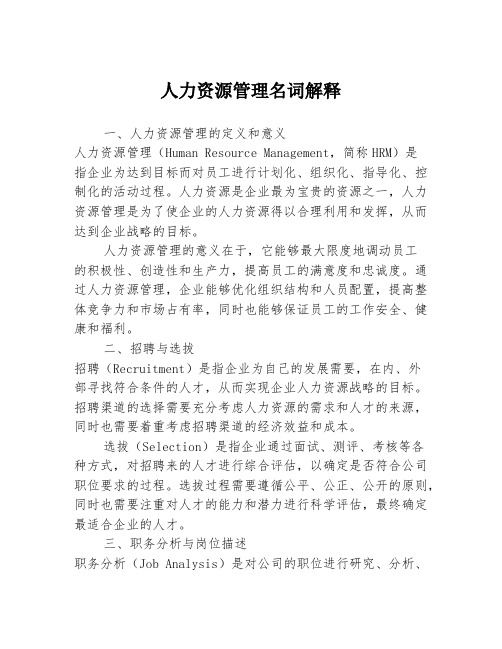
人力资源管理名词解释一、人力资源管理的定义和意义人力资源管理(Human Resource Management,简称HRM)是指企业为达到目标而对员工进行计划化、组织化、指导化、控制化的活动过程。
人力资源是企业最为宝贵的资源之一,人力资源管理是为了使企业的人力资源得以合理利用和发挥,从而达到企业战略的目标。
人力资源管理的意义在于,它能够最大限度地调动员工的积极性、创造性和生产力,提高员工的满意度和忠诚度。
通过人力资源管理,企业能够优化组织结构和人员配置,提高整体竞争力和市场占有率,同时也能够保证员工的工作安全、健康和福利。
二、招聘与选拔招聘(Recruitment)是指企业为自己的发展需要,在内、外部寻找符合条件的人才,从而实现企业人力资源战略的目标。
招聘渠道的选择需要充分考虑人力资源的需求和人才的来源,同时也需要着重考虑招聘渠道的经济效益和成本。
选拔(Selection)是指企业通过面试、测评、考核等各种方式,对招聘来的人才进行综合评估,以确定是否符合公司职位要求的过程。
选拔过程需要遵循公平、公正、公开的原则,同时也需要注重对人才的能力和潜力进行科学评估,最终确定最适合企业的人才。
三、职务分析与岗位描述职务分析(Job Analysis)是对公司的职位进行研究、分析、描述和评估的过程,通过职务分析可以确定一个职位所需的技能、知识、经验和个人素质。
职务分析是制定招聘、培训、绩效考核、薪酬管理等制度的前提基础,它既是管理人员进行组织设计的基础,也是后续人力资源管理的重要依据。
岗位描述(Job Description)是基于职务分析结果制作的职位说明书。
在岗位描述中,涵盖了这个职位对应的部门、上级、下属、职责、权限、工作要求、薪酬标准等重要信息。
岗位描述在制定职位要求、评定绩效和招聘时都具有指导意义。
四、培训与开发培训(Training)是为了提高员工工作技能、专业技术能力、降低工作风险和提高工作效率而进行的学习和训练活动。
人力资源管理专业英文简称

人力资源管理专业英文简称(Human Resource ManagementMajor Abbreviation)简介人力资源管理是一门涉及组织管理与人力资源活动的学科,它包括招聘、培训、绩效评估和员工关系等方面。
在全球范围内,人力资源管理专业被广泛认可,并且在各行各业中都扮演着重要的角色。
本文将介绍人力资源管理专业的英文简称,在职场中使用这些简称可以提高工作效率和沟通准确性。
1. HRMHRM是Human Resource Management的缩写,其是人力资源管理专业最常见的简称。
几乎所有人力资源专业人士都熟悉和使用这个缩写。
在商业界和学术界,HRM已成为指代人力资源管理的标准术语。
2. HRHR是Human Resources的缩写,与HRM相似,它在全球各地广泛使用。
许多公司在内部使用HR作为人力资源部门的简称,它是为了在组织中更加便捷地引用人力资源管理的职能和流程。
3. HCMHCM是Human Capital Management的缩写,这个词汇强调了人力资源作为组织资本的重要性。
与HRM略有不同,HCM更关注员工的能力、技能和智慧,强调人力资源的战略管理和组织绩效的提升。
4. ERMERM是Employee Resource Management的缩写,这个简称侧重于强调员工资源的管理和利用。
ERM着重于充分发挥员工的潜力,通过提供资源和支持,帮助他们达到个人和组织目标。
5. IHRMIHRM是International Human Resource Management的缩写,意味着国际人力资源管理。
随着全球化的发展,跨国公司与国际化的员工流动性增加,IHRM变得日益重要。
IHRM需要处理多种文化、法律和政策差异,以确保全球范围内的人力资源活动的顺利实施。
结论人力资源管理专业的英文简称在职场中被广泛使用,可以提高工作效率,准确传达信息。
无论你是从事人力资源相关工作的专业人士还是对这个领域感兴趣的人,熟悉并掌握这些简称对你的职业发展是非常有益的。
人力资源管理名词解释简答题
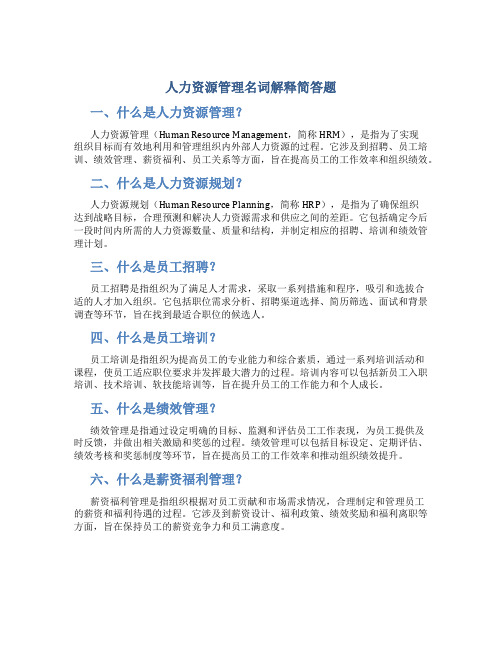
人力资源管理名词解释简答题一、什么是人力资源管理?人力资源管理(Human Resource Management,简称HRM),是指为了实现组织目标而有效地利用和管理组织内外部人力资源的过程。
它涉及到招聘、员工培训、绩效管理、薪资福利、员工关系等方面,旨在提高员工的工作效率和组织绩效。
二、什么是人力资源规划?人力资源规划(Human Resource Planning,简称HRP),是指为了确保组织达到战略目标,合理预测和解决人力资源需求和供应之间的差距。
它包括确定今后一段时间内所需的人力资源数量、质量和结构,并制定相应的招聘、培训和绩效管理计划。
三、什么是员工招聘?员工招聘是指组织为了满足人才需求,采取一系列措施和程序,吸引和选拔合适的人才加入组织。
它包括职位需求分析、招聘渠道选择、简历筛选、面试和背景调查等环节,旨在找到最适合职位的候选人。
四、什么是员工培训?员工培训是指组织为提高员工的专业能力和综合素质,通过一系列培训活动和课程,使员工适应职位要求并发挥最大潜力的过程。
培训内容可以包括新员工入职培训、技术培训、软技能培训等,旨在提升员工的工作能力和个人成长。
五、什么是绩效管理?绩效管理是指通过设定明确的目标、监测和评估员工工作表现,为员工提供及时反馈,并做出相关激励和奖惩的过程。
绩效管理可以包括目标设定、定期评估、绩效考核和奖惩制度等环节,旨在提高员工的工作效率和推动组织绩效提升。
六、什么是薪资福利管理?薪资福利管理是指组织根据对员工贡献和市场需求情况,合理制定和管理员工的薪资和福利待遇的过程。
它涉及到薪资设计、福利政策、绩效奖励和福利离职等方面,旨在保持员工的薪资竞争力和员工满意度。
七、什么是员工关系管理?员工关系管理是指组织通过建立良好的人际关系和沟通渠道,处理员工与组织之间的各种关系和问题的过程。
它包括员工沟通、冲突解决、员工投诉处理等方面,旨在维护员工满意度和减少员工流失率。
以上是对人力资源管理中常用名词的简要解释。
HRM是什么意思_HRM是什么职位
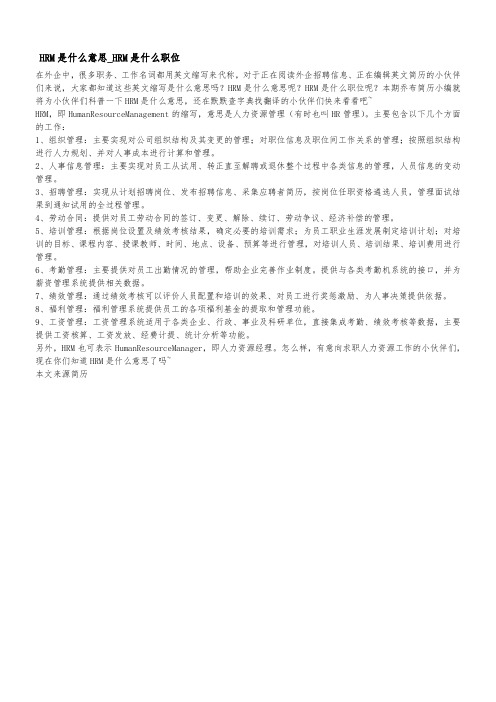
HRM是什么意思_HRM是什么职位
在外企中,很多职务、工作名词都用英文缩写来代称,对于正在阅读外企招聘信息、正在编辑英文简历的小伙伴们来说,大家都知道这些英文缩写是什么意思吗?HRM是什么意思呢?HRM是什么职位呢?本期乔布简历小编就将为小伙伴们科普一下HRM是什么意思,还在默默查字典找翻译的小伙伴们快来看看吧~
HRM,即HumanResourceManagement的缩写,意思是人力资源管理(有时也叫HR管理)。
主要包含以下几个方面的工作:
1、组织管理:主要实现对公司组织结构及其变更的管理;对职位信息及职位间工作关系的管理;按照组织结构进行人力规划、并对人事成本进行计算和管理。
2、人事信息管理:主要实现对员工从试用、转正直至解聘或退休整个过程中各类信息的管理,人员信息的变动管理。
3
4
5
管理。
6
7
8
9
另外,。
人力资源管理名词解释
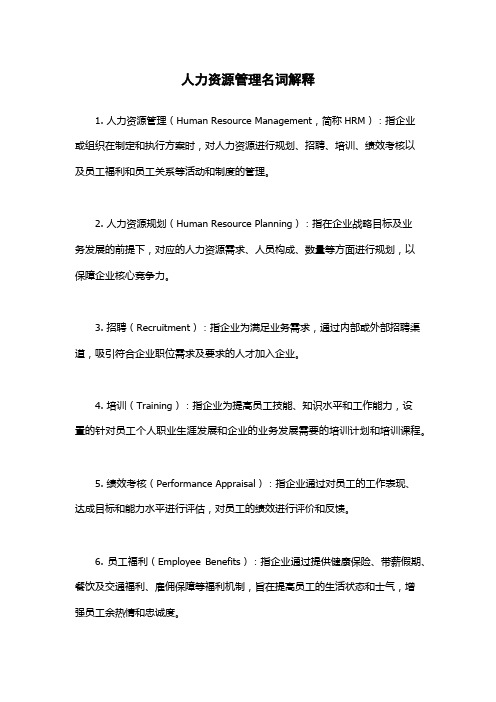
人力资源管理名词解释1. 人力资源管理(Human Resource Management,简称HRM):指企业或组织在制定和执行方案时,对人力资源进行规划、招聘、培训、绩效考核以及员工福利和员工关系等活动和制度的管理。
2. 人力资源规划(Human Resource Planning):指在企业战略目标及业务发展的前提下,对应的人力资源需求、人员构成、数量等方面进行规划,以保障企业核心竞争力。
3. 招聘(Recruitment):指企业为满足业务需求,通过内部或外部招聘渠道,吸引符合企业职位需求及要求的人才加入企业。
4. 培训(Training):指企业为提高员工技能、知识水平和工作能力,设置的针对员工个人职业生涯发展和企业的业务发展需要的培训计划和培训课程。
5. 绩效考核(Performance Appraisal):指企业通过对员工的工作表现、达成目标和能力水平进行评估,对员工的绩效进行评价和反馈。
6. 员工福利(Employee Benefits):指企业通过提供健康保险、带薪假期、餐饮及交通福利、雇佣保障等福利机制,旨在提高员工的生活状态和士气,增强员工余热情和忠诚度。
7. 员工关系(Employee Relations):指管理层与员工之间建立的合理、和谐及互动型的人际关系,以达到员工高效工作和企业增强竞争力的目标。
8. 组织变革(Organizational Change):指企业为适应外部经济、技术和市场等环境变化,对企业结构、流程和战略方向等方面进行改变的过程。
9. 职业生涯规划(Career Planning):指员工通过对自身能力、特长、兴趣爱好等进行分析,设计符合自己职业目标的职业发展路径,并通过定期跟踪、评估和改进等方式来实现。
10. 薪酬管理(Compensation Management):指企业通过制定公平合理的薪酬计划包括基本工资、奖金、福利等激励措施来吸引和留住优秀的人才,在员工调薪、晋升、离职等时刻给予合理的薪酬水平。
- 1、下载文档前请自行甄别文档内容的完整性,平台不提供额外的编辑、内容补充、找答案等附加服务。
- 2、"仅部分预览"的文档,不可在线预览部分如存在完整性等问题,可反馈申请退款(可完整预览的文档不适用该条件!)。
- 3、如文档侵犯您的权益,请联系客服反馈,我们会尽快为您处理(人工客服工作时间:9:00-18:30)。
• • •
A ‘collection of phenomena’ Is labour an unfortunate cost, or a critically useful asset? Two SHRM categories (and strategies):
(Beer et al., 1984)
•Analytical model, rather than prescriptive •Takes into account different philosophies and assumptions
The Warwick model
(Hendry and Pettigrew, 1992)
(Source: Mullins 2007)
Strategic HRM
• • • • Personnel management vs. HRM Strategy and alignment Vertical and horizontal integration Elements of Strategic HRM
Holbeche, 1999
Strategy and alignment
• Unitarist (shared) vs. Pluralist (divergent) conceptions • Contingency/Best practice approaches • Planned/Emergent approaches (or evolutionary Marchington & Wilkinson 2008) – truly embedded? • Generic strategies and HRM (Schuler & Jackson)
• Use of planning • Coherent approach to design and management of personnel systems • Matching HR activities and policies to explicit business strategy • People as a strategic resource for competitive advantage
How is HRM strategic?
• • • • Integration of personnel policies HRM responsibility shifts to line managers Shift from collectivism to individualism Stress on commitment - manager as enabler
•Based on the Harvard Model
•Gives recognition of external context
•Does not assume outcomes •Does assume coherent policies give rise to superior performance
Government view cited in Reader A 2006
‘The design, implementation & maintenance of strategies to manage people for optimum business performance including the development of policies & processes to support these strategies.’
Strategic management and environmental pressures
(Fombrun, Tichy and Devanna, 1984)
The human resource cycle
(Fombrun, Tichy and Devanna, 1984)
The Harvard framework
People Management Practices Staffing Work Design Training Participation Rewards Recognition Appraisal Communication
Means of maintaining on-going competitive advantage
1. 2. What are the ideal organisational measures (structures, processes etc) then seek to improve these What are the underlying ideas and forces (culture, that impact on organisational performance) – then (positively) influence these
(Hendry and Pettigrew, 1986)
Vertical integration
Link between environmental context, business strategies and personnel and development policies.
(Marchington and Wilkinson, 1986)
(Torrington and Hall, 2008)
Horizontal integration
The degree to which different aspects of Personnel and Development are linked together.
(Marchington and Wilkinson, 1996)
Models of SHRM
• • • • • Salaman, Storey and Billsberry Fombrun, Tichy and Devanna (Michigan) Beer and Spector (Harvard) Warwick model Guest’s model
Basic HRM Components
(Salaman, Storey and Billsberry, 2006)
‘Stock’ of employees Employees ‘free will’; owned by employees
Human Capital Pool Knowledge Skill Ability
Employee Relationships & Behaviours Psychological Contracts Job Related/required Discretionary Organisational Citizenship
(Sisson, 1989)
• Realisation of ‘human capital’ and ‘high performance’ workplaces for competitive advantage
(Salaman, Storey et al, 2006)
How is HRM strategic?
External fit
(Baird and Meshoulam, 1988)
Organisational integration
(Guest and Peccei, 1994)
Degree of integration
• • • • • Separation model Fit model Dialogue model Holistic model HR driven
Internal fit
(Baird and need for practices to be guided by conscious policy choices to increase the likelihood that practices will reinforce each other and will be consistent over time.
– There are fundamental differences between people as an asset and the traditional assets of finance or technology – An understanding of fundamental differences creates a new way of thinking and working in organisations – Business strategies can only be realised through people. – Creating a strategic approach to people necessitates a strong dialogue across the organisation
(Beer and Spector, 1985)
Elements in horizontal integration
• • • • Resourcing – involvement of HR Relations – Industrial/professional Reward – setting as part of policy Development – T&D as a coherent part
Source: Reader A. 2006
The nature of human resource management (HRM)
• Gratton: the significance of human resources as the most important organisational asset:
